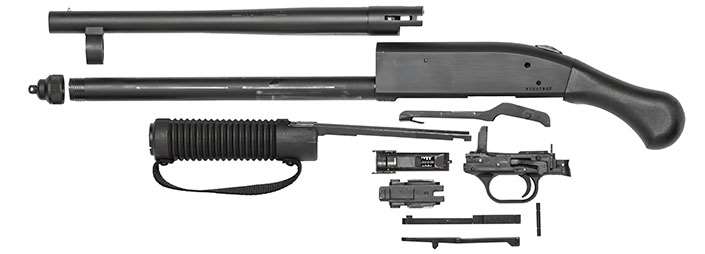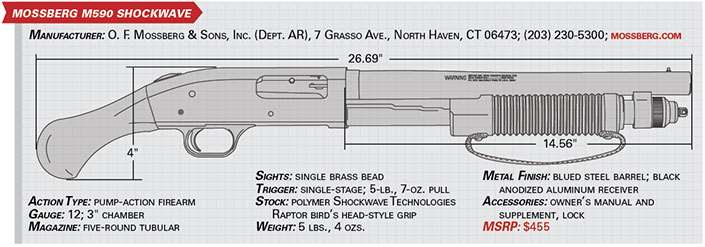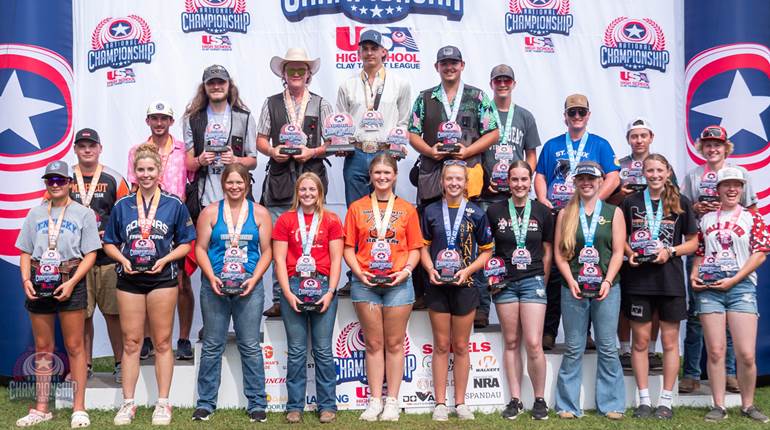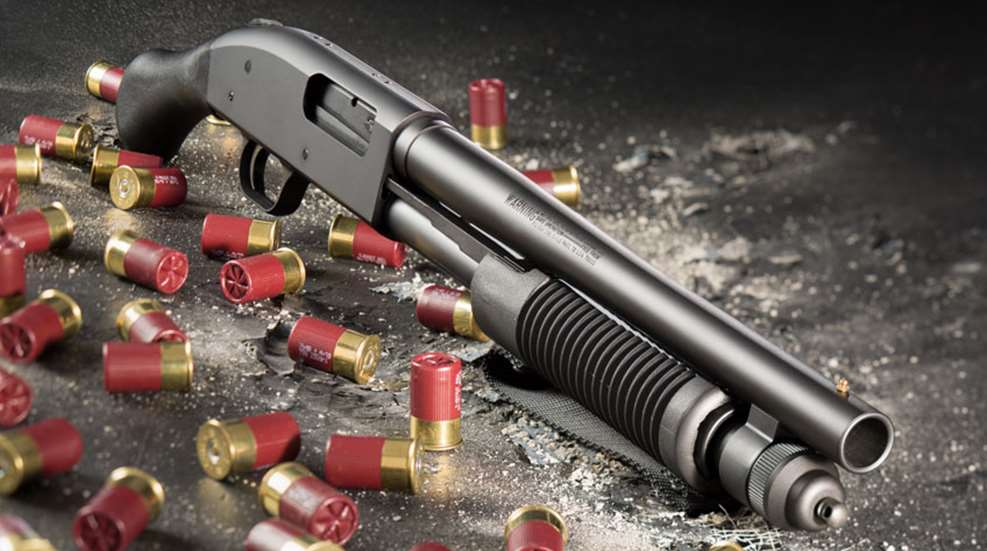
In the typical home, entering doorways (a.k.a. “fatal funnels”) and “slicing the pie” with a 24" to 28"-barreled shotgun reduces maneuverability, escalates exposure and, at corners, increases the likelihood of the barrel being seized by an intruder. With its M590 Shockwave, Mossberg offers a unique solution to these shortcomings by minimizing both the gun’s barrel and overall lengths.
Distinguishing the M590 Shockwave from its Model 500-series shotgun counterparts are interrelated features that improve its suitability for home defense, as well as change its designation with the Bureau of Alcohol, Tobacco, Firearms and Explosives (BATFE). Replacing the traditional buttstock is a polymer Shockwave Technologies Raptor bird’s head-style grip that adjoins a bead-sighted, 14 9⁄16" cylinder-bore barrel. The result is a 12 gauge with a short, 26 11⁄16" overall length.
According to a letter from Michael R. Curtis, chief, firearms technology industry services branch of the BATFE to Mossberg, dated March 2, 2017, “The weapon [Shockwave] ... is a ‘firearm’ subject to GCA [Gun Control Act of 1968] provisions; however, it is not a ‘firearm’ as defined by the NFA [National Firearms Act].” He added, “Please note that if the subject firearm is concealed on a person the classification with regard to the NFA may change,” as well as, “If the design, dimensions, configuration, method of operation or materials were changed [from the sample submitted], our determinations would be subject to review.” This doesn’t account for state or local restrictions.
In layman’s terms, the M590 Shockwave design is such that a pump-action 12 gauge with an NFA-length barrel can be purchased without NFA paperwork and tax. However, restraint from altering the existing design is mandatory; in fact, accompanying the Shockwave owner’s manual is a supplement stating, “This firearm, as delivered from the factory, is equipped with a Shockwave Technologies Raptor Grip only. Replacing the Shockwave Technologies Raptor grip with a buttstock or other pistol grip may change this firearm’s ATF classification, and may result in a violation of NFA regulations unless the proper ATF forms are completed, and the tax is paid.”
Beyond the barrel and Raptor Grip, another item unique to the M590 Shockwave is the fore-end featuring a Raptor Strap. Secured by four Phillips-head screws with washers, the 1¼"-wide strap helps control the firearm during firing and prevents the hand from slipping forward in front of the muzzle. Deep grooves in the fore-end enhance purchase, too. Feeding the Shockwave is a tubular magazine holding five 2¾" or four 3" 12-ga. shells. By using an OPSol Texas Mini-Clip (not included) and 1¾" Aguila Minishells, that number increases to eight. Securing the barrel is a magazine cap that is equipped with a sling swivel stud. Later-production Shockwaves also feature a stud at the rear of the grip.
Functioning of the M590 Shockwave mimics that of Mossberg’s M500-series shotguns. So too is placement and operation of the fire controls, including: the two-position, tang-mounted safety; action-lock lever; and single-stage trigger. On the test gun, the trigger had minimal creep, a short reset and broke consistently at 5 lbs., 7 ozs.
Ammunition for function testing the Shockwave included: 1¾", 5/8-oz., No. 7½ Aguila Minishells; 2¼" Herter’s Select Defense Mini-Buckshot (six 00 pellets); Rio 2¾", 1 1⁄8-oz. No. 7½ target loads; and several 3", 1 7⁄8-oz. No. 4 Remington Nitro Turkey loads. Given the Shockwave’s intent as a defensive arm, and also taking into account the maximum distance within most homes, patterning occurred at 15 yds. using the above Herter’s load.
A word of caution is necessary here. According to the M590 Shockwave manual supplement, “Never hold the firearm at eye level and attempt to sight down the barrel. To avoid injury, firmly grip the forearm with fingers inside the strap and one hand on the Raptor Grip. Raptor Grip models are designed to be held at waist level when firing.”
Since patterning requires sighting, we cradled the Shockwave in a sandbag rest, secured it with a nylon strap, and firmly held both the fore-end and Raptor Grip. Moreover, similar to shooting a scope-sighted handgun, the gun was fired with both arms extended. Despite having a cylinder bore, at 15 yds. the Shockwave delivered all six 00 buck pellets within the 21" inner ring on nine of 10 shots. A single flyer exited the inner ring on the tenth shot. Closer in, pellet distribution was minimal, emphasizing the importance of accuracy.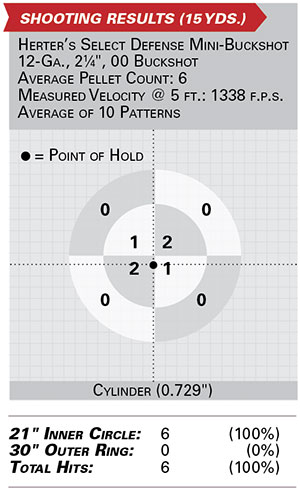 The trade-off for the truncated 14 9⁄16" barrel and Shockwave Raptor Grip (and thus short overall length) is the lack of a shoulder stock, which naturally would aid in sighting and recoil mitigation. Accurately firing the M590 Shockwave “from the hip” takes practice; don’t expect it to come naturally. But with time, hand-eye coordination and muscle memory will mesh—like throwing a baseball—and it gradually becomes easier to place shots on target.
The trade-off for the truncated 14 9⁄16" barrel and Shockwave Raptor Grip (and thus short overall length) is the lack of a shoulder stock, which naturally would aid in sighting and recoil mitigation. Accurately firing the M590 Shockwave “from the hip” takes practice; don’t expect it to come naturally. But with time, hand-eye coordination and muscle memory will mesh—like throwing a baseball—and it gradually becomes easier to place shots on target.
Thanks to the Mini-Clip, the Aguila Minishells cycled flawlessly; with it removed, the other shells did, too. There were no malfunctions. Recoil with the Minishells was minimal. The Herter’s and Rio loads had similar recoil levels, which was notably higher than the Aguilas and required a firm grip to control the gun. And then there were the 3" Remington Nitro Magnum Turkey loads; unsurprisingly, the heavy-hitting magnum loads were terribly jarring to the hands and were quite unpleasant to shoot. We don’t recommend firing 3" magnum loads in any configuration—especially those shooters who are smaller in stature or who might have difficulty controlling the gun. According to the Competition Electronics chronograph, at 1338 f.p.s. the Herter’s load averaged 88 f.p.s. faster than the published velocity.
The Mossberg M590 Shockwave isn’t for everyone. But for defensive-minded individuals demanding the proven threat-stopping capabilities of a 12 gauge in a compact, maneuverable and easily transported platform— and who are willing to spend time practicing on the range with it—the Shockwave is a top choice.
